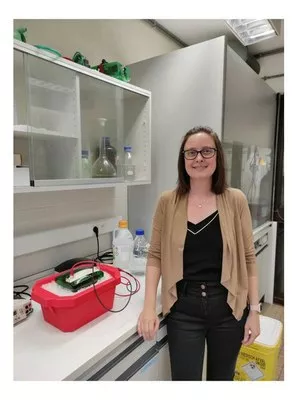How are the proteins that ensure the proper functioning of a lysosome specifically transported to this compartment from their production site in the cell?
This is the question that Marielle Boonen, a researcher in biomedical sciences, began her research at UNamur with.
“For a cell to be healthy, it must produce thousands of molecules in adequate quantities at each moment of its life. These molecules must be correctly formed and they must perform their function in the right place. To do this, the cell contains several stations for addressing the molecules; a bit like airports, railway stations or carpooling stations. To reach the lysosome, for example, a protein must have a valid boarding ticket (such as the mannose 6-phosphate signal) and enter a transport vehicle whose destination is the lysosome. This vehicle must also take a route that will bring it to its destination. These transport systems are very important for the optimal functioning of the lysosome and the cell as a whole.”
After her doctoral thesis, devoted to the study of a lysosomal protein and the signals that ensure its transport to the lysosome under normal conditions, Marielle Boonen wished to continue her work on the molecular transport mechanisms that allow a cell to function normally, while seeking to identify the causes and consequences, sometimes pathological, associated with their deregulation. She then began a post-doctoral fellowship with Dr Stuart Kornfeld at Washington University in St. Louis, Missouri, USA. During these years, she had the opportunity to study the consequences of inactivating a transport pathway to lysosomes in various organs.
"One of these consequences turned out to be a disruption of the secretion of lysosomal enzymes by bone cells called osteoclasts. It is important to note that bone is continually being renewed. Cells called osteoblasts produce the bone matrix, while osteoclasts resorb this matrix. To do this, the osteoclasts must release the contents of their lysosomes when they come into contact with the surrounding bone matrix. Together with Dr Kornfeld, she will learn about several techniques for culturing and analysing the proper functioning of osteoclasts."

On her return to UNamur, Marielle Boonen focused on the search for other lysosomal enzyme transport pathways, including the HYAL1 enzyme.
"In the course of experiments in Dr Kornfeld's laboratory, I found a clue that HYAL1 might be expressed in osteoclasts and in the cells from which these cells are derived: macrophages. HYAL1 is an enzyme that digests hyaluronic acid. This is a glycosaminoglycan (a type of sugar) that has multiple functions in the body: hydration of the skin, healing, maintaining the elasticity of certain tissues such as cartilage, etc." At UNamur, two research teams are working on the development of the enzyme HYAL1.
At UNamur, two professors from the Molecular Physiology Research Unit (URPHyM) had already started to study this enzyme. Professor Bruno Flamion, an expert in the field of hyaluronic acid and the enzymes that fragment it, and Professor Michel Jadot, who specialises in the study of the lysosome, its biogenesis and its functioning. Working together with Marielle Boonen, with a PhD student in biomedical sciences, Emeline Puissant, and with the help of laboratory technicians (including Florentine Gilis and Virginie Tevel), the project expanded, first in the field of intracellular transport of HYAL1 to lysosomes in macrophages and osteoclasts, and then in the role of this enzyme in bone.
In the course of their research, several discoveries led the research team to explore whether HYAL1 could play a key role in the process of bone remodelling: "We found that a deficiency in HYAL1 causes a loss of bone density in a mouse model. This phenotype results from a loss of bone-forming activity by osteoblasts, and an increase in bone resorption by osteoclasts when these cells no longer express the HYAL1 enzyme.
"These important discoveries place the HYAL1 enzyme as a central player in bone remodelling, extend our knowledge of the consequences of its deficiency, and open the door to new avenues of research concerning possible deregulations of HYAL1 in various bone pathologies," concludes Marielle Boonen.
Cross-disciplinary research between biomedical sciences and veterinary medicine
In the course of their research, the research team called on Professor Jean-Michel Vanderweerd, from the Department of Veterinary Medicine, who specialises in the study of osteoarticular pathologies. "With his help, we were able to use state-of-the-art equipment to perform bone density measurements in his laboratory. We were also able to benefit from Jean-Michel Vanderweerd's expertise to guide us in the interpretation of certain results and observations.
A rich collaboration for a project combining expertise and interests that at first seemed far apart.
"The path that led to these important discoveries is a fine example of fundamental research without preconceptions, initiated from an intriguing question concerning the transport of lysosomal proteins, and which has evolved from discovery to discovery thanks to a combination of expertise and very good teamwork," Marielle Boonen is delighted to say.
Marielle Boonen is a doctor in biomedical and pharmaceutical sciences. She is a member of the Narilis research institute, the Molecular Physiology Research Unit (URPhyM) and heads the Laboratory of Intracellular Traffic Biology (LBTI).